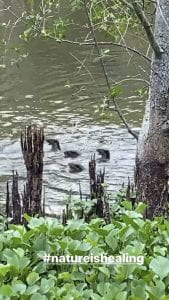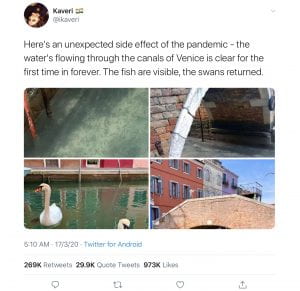Hi guys, welcome back! This week’s post is on the impact of COVID-19 on urban wildlife. 
In Singapore, one of our most commonly discussed urban animals are the otters. I took the video above in April(during the circuit breaker), hopping onto the #NatureisHealing trend.
What is #NatureisHealing? During lockdowns, cities were quiet as people were forced to stay home. People started spotting animals in places they usually didn’t and these were typically urban areas. And so, #NatureisHealing was born, a hashtag where people uploaded photos and videos of these animals in places they would not usually be found in. These posts mostly praised the resurgence of wildlife in urban areas. Here are a couple of the more popular posts.


(More animal sightings covered in this article by CNBC)
However, I wondered just how true these posts were. Were these sightings really as extraordinary as they seemed? Were they even real sightings or merely fake news? After some digging, I found that these posts were not entirely true.
What’s true:
- Animals were gaining from the absence of humans. In Florida, reports showed that there were more leatherback sea turtle nests than last year. This was attributed to empty beaches during the lockdown.
- Air quality improved. Air pollution in Delhi fell to its lowest levels in years(cite other source). Officials in Venice also reported cleaner air resulting from reduced traffic.
- Water clarity improved. Namely, reduced marine traffic in Venice resulted in clearer waterways.
What’s false:
- Some sightings of animals were not rare or unique. They were common sightings even before COVID-19
- Some posts falsely claimed sightings – the photos/ videos were actually taken elsewhere.
I also considered if these animal sightings were over-glorified. The internet was hyping up seeing these animals in such odd places. Was the appearance of animals in urban areas really a good thing or was it actually a bad sign? Turns out, things really aren’t as good as they seem.
The lack of humans around led to a loss of food for some animals. Hungry, they ventured out of their comfort zones for the sake of food. This resulted in sightings of animals in places they wouldn’t usually be in. In Japan, Sika deer were seen on the streets of Nara when they would usually only be seen in the Nara-Koen Park. The reason for this, as reported by local news, is the lack of tourists. Without tourists, the deer were forced to leave the park for food. In Thailand, a video of numerous macaques fighting over food went viral. Experts say that such a large fight is likely caused by lack of food. Similar to the deer in Nara, the macaques are usually fed by tourists. Thus reduced tourism likely caused the macaques to roam out of the temple they live in.
It was surprising to learn that an internet trend that made this pandemic just a little brighter turned out to be somewhat of a hoax. If one good thing were to come out of #NatureisHealing, perhaps it is that people are now more aware of how human activities have affected wildlife. On that note, I hope that people and organisations around the world will step up to protect our urban animals.
Hi Rachel,
I wouldn’t go so far as to call the whole hashtag a hoax – I doubt the common sighting ones were done to delibrately mislead us. I guess it also shows how unaware we were of our urban creatures and everyone was on the lookout during COVID for some good news. Its a pity that we need a crisis to understand more about the world we live in, but we should continue to build on that and not let the crisis go to waste.
Cheers,
STEK
Hi Ee Kin,
To clarify, by “hoax” I just meant that the people sharing the urban sightings and fake news hyped them up too much and misled many people. Sorry for any misunderstanding! I definitely agree that we can and should learn to appreciate the environment more during this pandemic.
Thanks for commenting!
Rachel